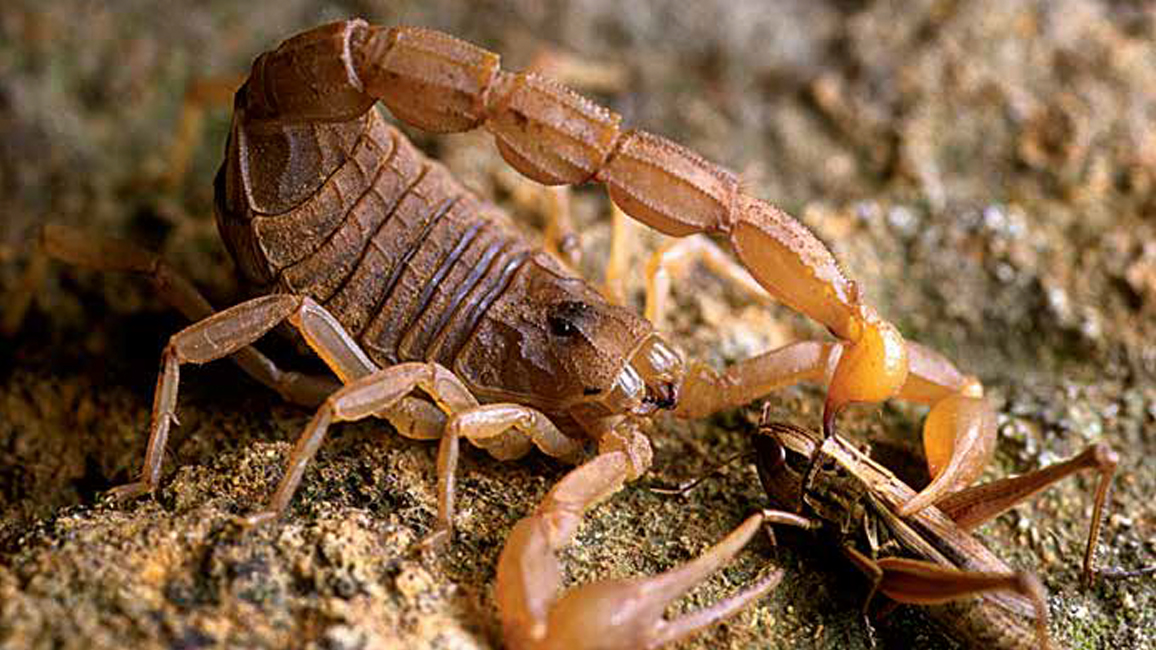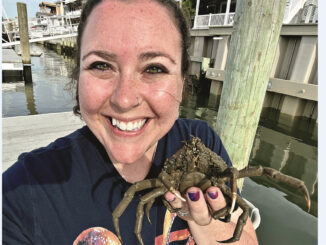
Scorpions
By Gerry BishopThe night is dark and still. But the desert floor is alive! Everywhere, eight-legged creatures are in search of a meal: insects, spiders, small lizards—even each other. Some go on the prowl while others lie in wait to ambush their prey. They’re scorpions, doing what scorpions have been doing for over 400 millions years.
There are about 2,000 species of scorpions, and they’re found on every continent except Antarctica. Most scorpions live in deserts and other dry places. But they also live in forests, on mountains, along seashores, in caves, and even in people’s homes!
THE FEAR FACTOR
Many people are afraid of scorpions, and you can’t really blame them. The bad rap most likely comes from a scorpion’s fierce-looking claws and stinging tail.
You can see that the yellow scorpion (above) has caught a locust with its claws and is zapping it with the stinger on the tip of its tail (see close-up photo above). The sting delivers a shot of venom. The venom paralyzes the locust so it can’t escape. Then the scorpion will tear it to bite-sized bits—good food for a hungry hunter!
It’s true that up to 5,000 people around the world die from scorpion stings every year. But of all the species of scorpions on Earth, only about 25 are dangerous to people. And only one of those species lives in the United States: the Arizona bark scorpion. The rest are no more harmful than bees or wasps.
SCORPIONS BIG AND SMALL
The first scorpion-like creatures lived in the sea, and some grew to be eight feet long. The first true scorpions to appear on land were up to three feet long. But today they’re much smaller. Some of the biggest species are the giant forest scorpions of Southeast Asia, such as the one above. These may top out at eight inches. Then there are the really tiny ones. The yellow-tailed scorpion (small photo top right) grows to be only a bit more than an inch long. But the very smallest scorpion is only about half that size. One could sit on your thumbnail with room to spare—if you let it.
HOME IN A HIDEY-HOLE
Nighttime is the right time for scorpions to be out and about. Their eyes are so sensitive that they can see by the light of the stars. And the hairs on their bodies can pick up the slightest movement. During the day though, they’re nowhere to be seen. Some hide under rocks, tree bark, or dead leaves. Others dig burrows to hide in. There they stay, safe from predators and from temperatures that are too hot or too cold.
Scorpions that dig burrows have the right tools to get the job done. Their front claws are huge and powerful. They bulge with muscles. These claws also come in handy for another important job. The scorpion above is nicknamed “The Crusher”—and for a good reason. It grabs its prey in its claws and crushes it to death. Most times, it doesn’t even need to use its stinger.
GLOW-IN-THE-DARK CREATURES
Scientists who study scorpions have a tricky way of finding them. They go out at night with a kind of light called a “black light.” When the light shines on a scorpion, the scorpion glows with a weird, neon blue-green color. What’s going on?
Scorpions have a special chemical in the outer layer of their hard skins. Under a black light, this chemical glows so brightly that you can spot a scorpion from 60 feet away.
All scorpions glow, even ones that have been dead for a long time. No one knows for sure why scorpions glow the way they do, but scientists are trying to find out.
BABIES ON BOARD
Animals without backbones—insects, spiders, crabs, and lobsters, for example—almost always lay eggs. But scorpions are different: They give birth to their young.
As soon as a baby scorpion is born, it crawls up onto its mother’s back. Pretty soon Mom is loaded down with as many as 100 little ones. She carries them wherever she goes, protecting them from harm.
A few days to a couple of weeks later, the babies molt, or shed their outer skins. They were born defenseless, but after molting they’re ready to face the world. They soon crawl down from Mom’s back and go off to try to survive on their own.
A WORLD OF DANGER
Survival for a young scorpion isn’t easy. The smaller scorpion in the photo above right had just crawled out of its old skin. Then, defenseless in its still-soft new skin, it was caught by the larger scorpion. You can guess what happened next!
But even older and bigger scorpions face all kinds of dangers. They may try to defend themselves with their stingers. But often they’re no match for larger spiders, centipedes, birds, shrews, bats, and lizards like the one above, top.
So next time you hear someone say how dangerous scorpions are, you can tell them how dangerous it is being a scorpion!
“Scorpions” originally appeared in the September 2013 issue of Ranger Rick magazine.
(Click on each image above for a closer view of the story.)



















